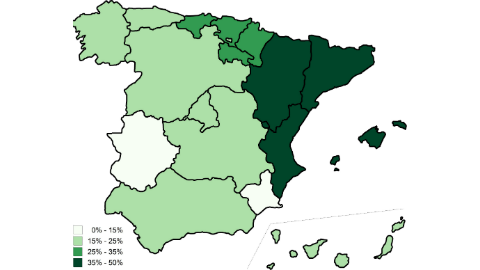Agreement between spouses determinant in gaining joint custody

13/11/2017
The study “La custòdia compartida: un pas més cap a la igualtat de gènere?" ("Joint Custody: a step towards gender equality?") published today by the Centre for Demographic Studies of the UAB in the journal Perspectives Demogràfiques http://ced.uab.es/PD/PerspectivesDemografiques_008_CAT.pdf points to the fact that previous pacts between spouses is the main element pointing towards greater gender equality, by means of gaining joint custody of children after a separation.
The joint custody map clearly defines two Spains. All autonomous communities which today contain a joint custody law are clearly above the Spanish average: Catalonia, Aragon, Valencia, Navarra and the Basque Country fit into this category. The exception seen is in the Balearic Islands and La Rioja, which do not have a specific law, but do have a very favourable number of joint custody cases. In addition to these laws, the existence of more egalitarian gender roles within a family and in society in general, especially in the distribution of productive work and care of children, are key elements.
A Study of the Family Courts of Barcelona
-In domestic partnerships there are less joint custodies than when a couple files for divorce. Those who live together in common-law marriages demonstrate a higher degree of conflict – are more inclined to file for lawsuits in which a judge has the last word - than married couples and also less joint custodies.
-A couple's origin is an important factor. It is four times more likely for parents to acquire joint custody when both members have Spanish nationality in comparison to couples in which neither is Spanish. The father's place of origin is much more important than the mother's, in which joint custodies are granted (or agreed upon) when the father holds a Spanish passport, but not the mother, than when it is the other way around.
-More joint custodies are granted when the children are between 6 and 11 years old.
-Social class, a good indicator of joint custody. The study shows that those with higher income levels agree to joint custody in 42% of the cases, while lower income levels file for joint custody in 24% of the cases and 32% among those with a medium income level.
-Agreement between spouses, a key element. It is three times more probable to be granted joint custody when the separation is agreed upon, i.e. the result of a mutual agreement, than when there is conflict and a judge is the one to have the last word, i.e. judicial process.
What happens after the case is solved?
Although the study does not give researchers the chance to delve deeper into the sustainability of the agreements reached, it did allow them to analyse the agreements and form an idea of how things would go after the separation:
-Mutually agreed on joint custody: equality between father and mother in amount of time and money dedicated to caring for their children. According to the legal decisions, joint custodies granted after spouses had reached a mutual agreement, the equality maintains throughout time: children under 18 years old sleep half of the nights in each of their parents' houses, regardless of the type of day. Often there is no alimony or both parents pay an alimony.
-Full custody for the mother: an old paradigm. When the mother has full custody three important differences can be seen: (1) the amount of nights spent with their father, in which they sleep almost all nights with their mother; (2) the difficulty of balancing different aspects, in which there is a larger difference between weekdays and weekends and holidays, making it difficult to balance out productive and reproductive environments; (3) alimonies, in which the money invested in the child is almost exclusively responsibility of the father.
-Joint custody after a legal battle: not as much equality. When joint custody is not agreed upon, but ordered by a judge, there is total equality in weekends and holidays, but not in weekdays, causing more difficulties to balance out work and parenting. There is also an intermediate point with regard to alimony, in which half of the cases it is the father who pays them.
Joint custody represents an advance if it is seen as a reflection, as stated in the laws of Catalonia, of the co-responsibility held previous to the separation. “An adequate legal response should not consist in imposing joint custidy, but in taking into account the conditions prior to the separation”, say Montse Solsona and Marc Ajenjo, authors of the study conducted by CED-UAB.
The article goes on to say: “However, if joint custody is granted indiscriminately, the conflict between parents could escalate, as well as the inequalities”.
Therefore, the study reaches the conclusion that applying laws that do not take into account the peculiarity of each case and its history, and which ignores that measures cannot be imposed within a still existing context of gender inequality, can clearly be counter-productive.
The article published in Perspectives Demogràfiques forms part of the project on different joint custody contexts after separations, entitled "La custodia compartida después de una rutpura de unión. ¿Qué contextos favorecen este paradigma emergente?" and funded by the Nationa R&D&I Plan of the Spanish Ministry for Education and Science.
ORIGINALARTICLE: http://ced.uab.es/PD/PerspectivesDemografiques_008_CAT.pdf "La custòdia compartida: un pas més cap a la igualtat de gènere?" Montse Solsona and Marc Ajenjo, Centre d'Estudis Demogràfics i Universitat Autònoma de Barcelona (CED-UAB). October 2017.